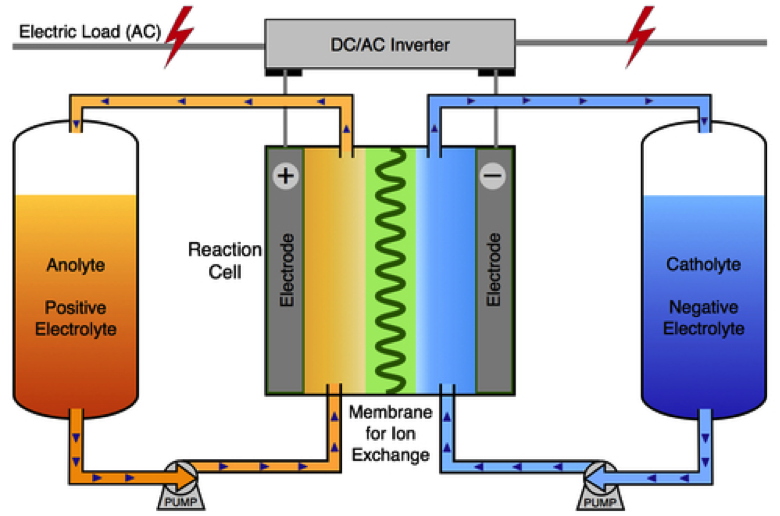Renewable energy technologies – solar PV in particular – are on the cusp of changing the energy landscape. In combination with the right load profile and in the right settings, solar‑powered electricity has reached a point where it is more cost‑efficient than combustion generators.
But to make that next big step we need to find a solution which enables cost-effective energy storage, a capability which will remove the issue of intermittent electricity generation that comes with PV-only energy systems*. When that day comes, it will be a game-changer. It will make the masses seriously question the role of combustion generators in our energy mix. A boost for energy storage is a boost for solar.
Of all the interesting energy storage technologies out there in development, the front runner in the race to dominate distributed energy storage appears to be the flow battery. The flow battery is an advanced battery design which brings a unique set of challenges and opportunities, lying in the middle of the spectrum between high-cost high-performance lithium ion units and value-for-money lead acid types.
How does a flow battery work?
A flow battery primarily consists of:
- Two separate liquids containing electroactive chemical elements dissolved in solution;
- A specially designed membrane to prevent the two solutions from mixing whilst allowing for ion exchange (i.e. movement of electric charge) to occur through it;
- An electrochemical cell that enables the extraction of stored chemical energy in the solutions for use as usable electricity in an external circuit; and
- Storage tanks and pumps to cycle the solutions through the cell.
Schematic of a flow battery [Image Credit: University of British Columbia]
As the two solutions are cycled through the electrochemical cell, ion exchange (i.e. current flow) occurs between the two solutions and through the separating membrane. Electricity can then be extracted via contacting electrodes and used to drive a load in an external circuit. Flow batteries are also called ‘redox flow batteries’, as a reference to the reduction and oxidation reactions occurring in the solutions during operation.
To recharge the flow battery the process is simply reversed by applying an opposite voltage to the electrochemical cell, causing electric charge to move in the opposite direction.
In comparison to lead acid batteries, the energy is stored as the dissolved electroactive material in the solutions rather than as a plated solid metal in the battery casing. Thus, the power and capacity characteristics of flow batteries are decoupled and can be adjusted independently of each other – the storage tanks can simply be made larger if an increase in total kilowatt-hour storage is desired.
Pros and cons
The solutions used in the more common flow batteries can be recharged indefinitely, potentially leading to longer operating lifetimes and a lower levelised cost of storage (LCOS). In addition, batteries can be rapidly recharged by simply exchanging spent solutions with a fresh batch. This ‘fast refuelling’ capability is attractive also for application in electric vehicles.
However, the need for pumps, flow controllers and storage tanks complicate the operation of the system and further reduce the overall energy density of flow battery units. While the solution may hold an indefinite lifetime, the components transporting corrosive electrochemical solutions may prove to be a weak link if implemented incorrectly. Flow batteries also require more complicated electronics when compared to more basic lead-acid battery designs.
How will flow batteries promote solar PV and renewable energy deployment?
Companies such as Imergy, Redflow and EnerVault have already released flow battery units competing directly with standard combustion generators, for both on- and off-grid applications. Some of these commercially available units are claiming a LCOS more competitive than peaking gas plants and are on their way to phasing out the more expensive combustion generator technologies. The continued progression of batteries in this capacity helps open the door for solar PV and other renewable energy technologies to fill the void.
* Not all renewable energy technologies share the same generation profile – the summation of different types of renewable energy technologies can result in a reasonably stable supplement to base loads. Hydroelectric plants, wind turbines, wave energy generators and solar PV systems operate independently. For example, wind turbines can generate at night as PV systems lay dormant, while remaining stationary in the heat of the day when solar panels are most productive. A distributed hybrid system could do wonders for the resilience of our electricity grid.
Top Image Credit: Nikkei Business Publications
© 2015 Solar Choice Pty Ltd

With this batteries really seem to have come of age! All the PV output finds a compact place especially when power managers like solarimmersion are here to send even fractions of power into the batteries.